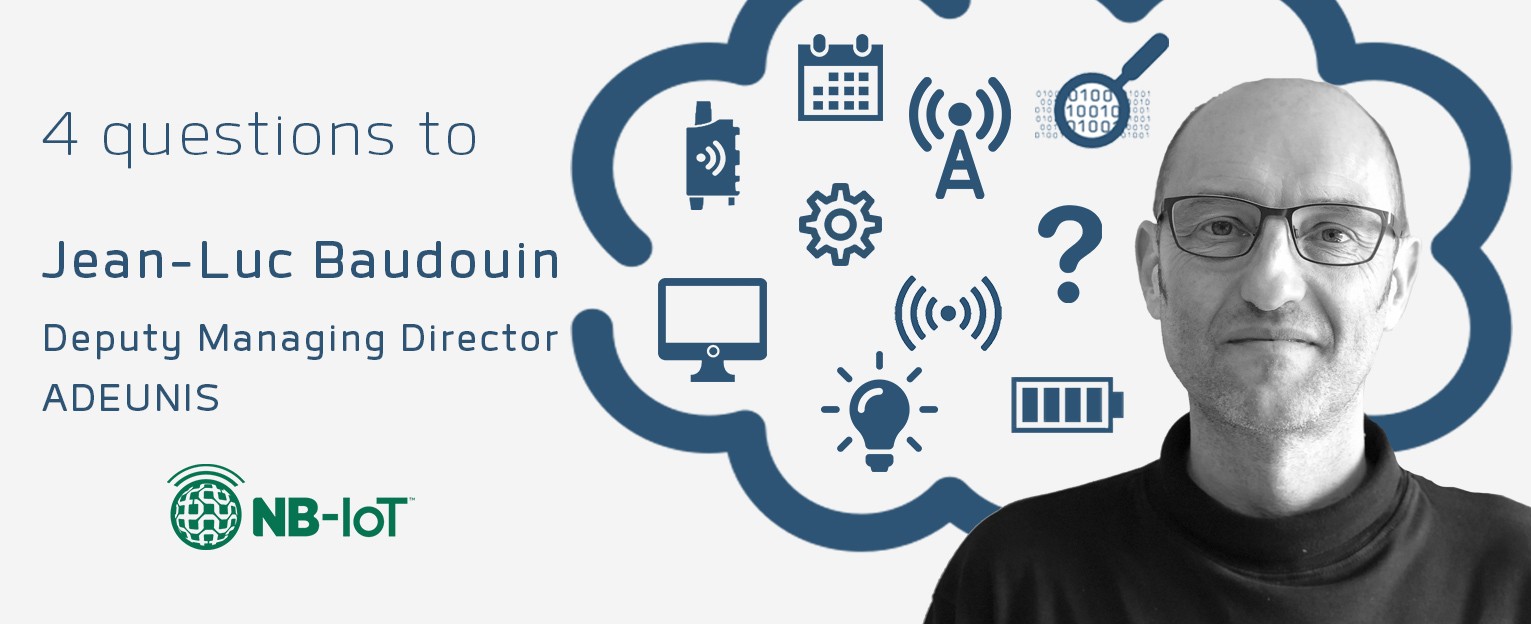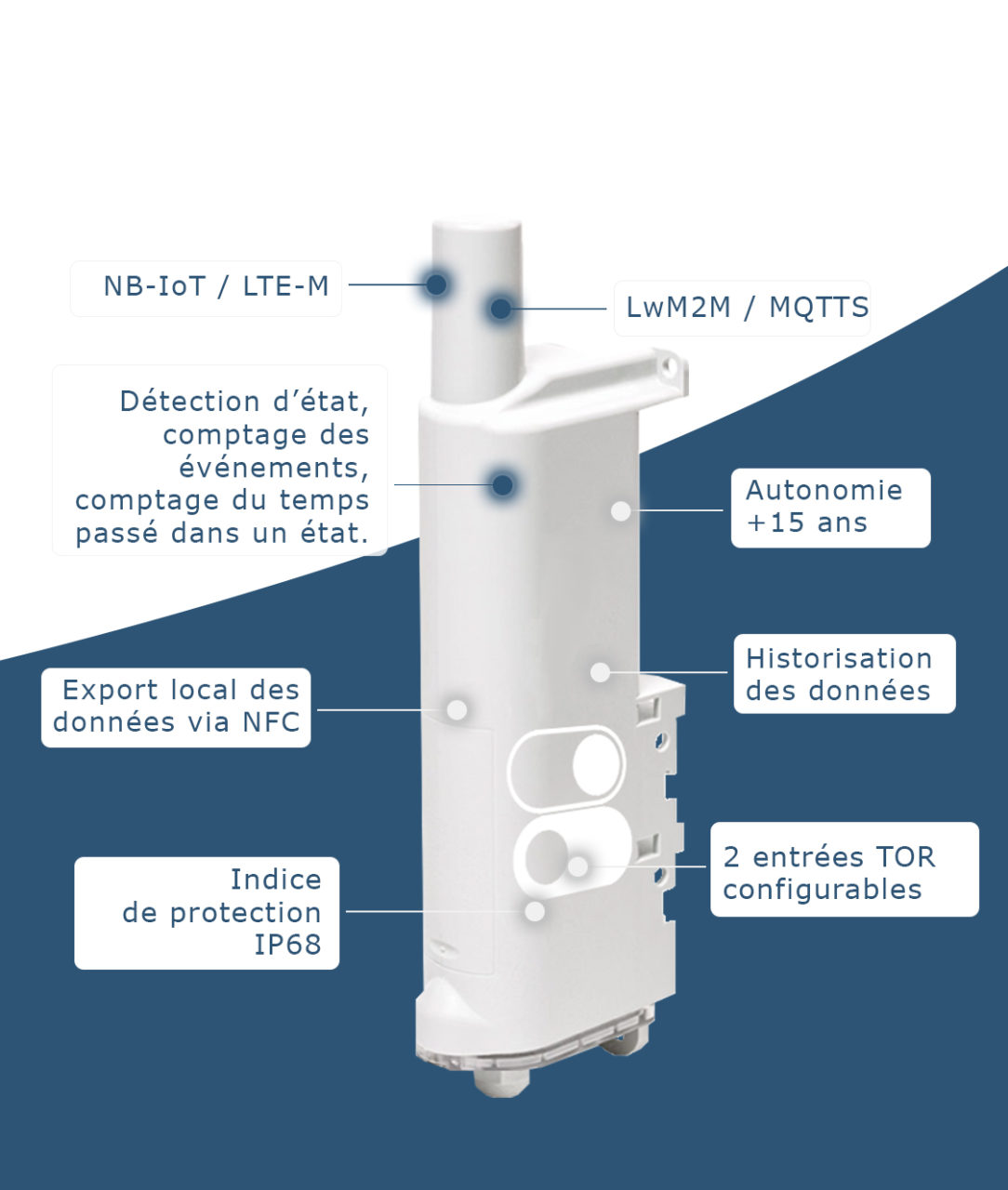
NB-IoT
Adeunis’ R&D and marketing teams have been collaborating for several months on the integration and implementation of an NB-IoT sensor. This project should be completed during the first quarter of 2021, when the sensor will be released: the PULSE for meter reading.
Jean-Luc Baudouin, Managing Director of Adeunis, tells us a little more about the progress of this project and the choices made by the Adeunis teams.
Why choose the NB-IoT protocol rather than LTE-M1?
We are talking here about two protocols specified by 3GPP release 15, which belong to the world of cellular protocols (such as 3G, 4G and future 5G), but adapted to IoT products for low speed, long range use cases.
Market studies indicate in the coming years a 50/50 positioning between NB-IoT and LoRaWAN in terms of market share. We believe that this proportion could be even higher in favor of NB-IoT, especially outside France.
We have studied LTE-M1 in the past, notably during the Orange/SNCF Challenge. This protocol can be considered as “closer” to 3G because it allows richer applications than just sending data, including the management of images or sounds. The use of these richer functions is to the detriment of consumption and therefore autonomy.
As Adeunis is positioned on applications dedicated mainly to Smart Building or Smart City, where throughput requirements are relatively low and lifetime requirements are high, we have naturally focused our efforts on the NB-IoT.
Is the eco-system ready?
The eco-system is beginning to take shape. For the moment we can speak of an eco-system in the early stages of maturation. Some operators such as Vodafone, Swisscom, Telia or SFR, for example, have already deployed their networks and offers. On the other hand, data processing platforms are still in their infancy among operators.
On the device side, industrialized offers are under development and should be on the market in about 12 months. It benefits from NB-IOT radio modules that are already operational, industrialized, certified and offered by several manufacturers.
Regarding usage and customers, tests for Adeunis are currently underway around the PULSE sensor.
Indeed, the segment that seems buoyant to date is counting, as traditionally in the IoT.
There are also emerging demands for more “traditional” uses of smart buildings (monitoring of temperature, humidity, etc.) in countries where the deployment of Sigfox or LoRaWAN networks has not been carried out by operators and where the NB-IoT is gaining momentum.
Will the NB-IoT sensors from Adeunis be of the “same nature” as those in the current catalog?
I would say yes and no.
Yes, if we look at their form factor, their lifetime or if we compare the operating and installation philosophy: provisioning on a network, attachment to the network, star bidirectional communication?
On the other hand, if we look inside the sensor and in particular the radio part and the power supply part, these have had to be almost completely reworked to guarantee proper operation while having an autonomy equivalent to our current products. Our products also integrate nano SIMs, which was not necessary for LoRaWAN or Sigfox.
The industrial and logistic aspects are also quite different, especially if you want to change operators during the life of the products.
For our customers, the main changes will be around the data management and pricing associated with this technology.
Concerning the data recovery aspects, the NB-IoT brings into the IP world and the data does not necessarily need to transit through an operator backend platform. In addition, the IP protocol used by the product determines the way the server must retrieve the data. So you have to choose between a simple UDP, MQTT or LWM2M format, for example. These choices should be made when the sensor is being designed.
The cost of subscriptions in NB-IoT is more and less the same as those in LoRaWAN. However, they are not always fixed in time. On the IoT sensor side, the cost of the modules is still high (more than 12€) and the specific design linked to the specificities of NB-IoT necessarily brings an additional cost. The overall cost, which will decrease over time, can be estimated at 50% more than a LoRaWAN product.
Is the performance there?
We are currently starting tests with several of our customers in France and Europe. It is still a little early to say that all the promises are there, especially since some network mechanisms (such as network attachment, TAU negotiations, etc.) depend on the implementation of the network by an operator.
Nevertheless, we can say that the tests we have already carried out in the field and in the laboratory, in France and abroad, allow us to affirm the following elements:
~1000
Bytes per frame
<3%
PER <3%
32
up to 32 repetitions
0
limit to the Duty Cycle
- The repetition mechanisms allow a very good penetration indoors and underground. There can be up to 32 repetitions (ref. 3GPP Release 13) without the sensor consuming 32 times more. The transmission levels in parking lots or subways for example, are good.
- The average consumption that occurs mainly in the attachment and transmission phases is 4 times higher for the same use case than in LoRaWAN. Nevertheless, we remain in the world of low consumption protocols.
- The frame loss rate (PER) is very low in NB-IoT (<3%), even in extreme conditions (basement, parking, etc.) and reflects the robustness of the protocol.
- Radio coverage is quite wide in NB-IoT, benefiting from the cellular network infrastructure and the deployment of existing antennas by operators.
- The amount of data sent over the NB-IoT network is much higher than what is possible over LPWAN networks such as LoRaWan (51 Bytes in SF7 and 242 Bytes in SF12) and Sigfox (12 Bytes maximum). Product data can be aggregated into a single frame and sent over the network (~1000 Bytes per frame) without any significant impact on product consumption.
- No restrictions or limits regarding the Duty cycle. The data can be sent by the product successively in NB-IoT (advantage of licensed bands), which is not the case on Sigfox and LoRa networks. This also applies to downlink messages (sent from the server to the product).
25/09/2020
expertise to support you, from the diagnosis to the implementation of your solution


